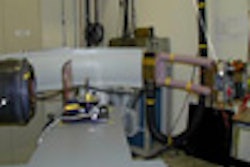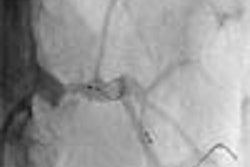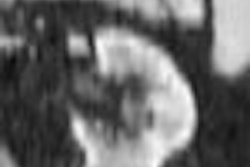SAN FRANCISCO - Early studies suggest that virtual colonoscopy without cathartic bowel preparation is feasible and sufficiently accurate to detect significant colorectal lesions. The potential payoff in screening compliance is huge. But while prepless VC may make patients' lives easier, it complicates matters for radiologists performing the exams -- and for scientists struggling to solve the myriad problems associated with examining the uncleansed colon radiographically.
In talks Thursday at the 9th International Symposium on Multidetector-Row CT sponsored by Stanford University in California, Dr. Michael Zalis discussed several issues that impact the emergence of a kinder, gentler colon screening exam, from compliance to tagging to electronic cleansing.
Colorectal cancer remains the second most common cause of cancer death in the U.S., and while good tests are available to screen for advanced polyps before they have progressed to cancer, less than half of all screening-age individuals are ever tested. The unpleasantness of the cathartic bowel preparation required for both virtual and conventional colonoscopy has been shown in several published studies be the major inhibiting factor for screening compliance, according to Zalis, who is director of CT colonography (CTC or VC) at Massachusetts General Hospital in Boston.
"Anything we can do to make (screening) patient-friendly in minimum-preparation techniques may improve screening compliance, and hence improve the overall mortality associated with colon cancer," Zalis said. "CTC is the unique structural exam with the potential to address this issue, in the sense that it has the unique ability to bring unexamined individuals into the screening paradigm."
Unique also because unprepped optical colonoscopy isn't feasible. Technically, of course, there's no such thing as prepless virtual colonoscopy either; even the term minimal prep is imprecise, Zalis said.
But the avoidance of cathartic preparation in colon screening has become a kind of holy grail for VC research, he said. Some form of bowel prep will always be required, in the form of easy diet modifications such as the temporary avoidance of dietary fiber and ingestion of tagging agents 24-48 hours before CT imaging. But these measures do not significantly impact the patient.
Fecal tagging uses positive oral contrast to augment or replace cathartic agents, giving residual stool a distinct hyperdense appearance on CT. The contrast "importantly is not absorbed by folds or polyps, so that at cross-sectional imaging polyps remain at soft-tissue attenuation, but we've raised the attenuation of the ingested food in the colon so we can see the distinction between the two," Zalis said. The use of tagging appears to improve the performance of unprepped CTC according to a number of studies.
Electronic cleansing (EC) uses advanced image processing techniques to remove the tagged colonic contents from the virtual colonoscopy images, leaving polyps and other important structures untouched. "And by that we emphasize cleaning after the image acquisition rather than physically cleansing the patient before," Zalis said.
The two most common agents are barium sulfate and both ionic and nonionic iodinated contrast agents; the latter will likely have a growing role in virtual colonoscopy because of their excellent performance characteristics. Barium, the traditional agent, is usually added to the diet one to two days before imaging. But it has a few disadvantages, Zalis said.
"Barium is relatively insoluble in enteric fluid and has to be coaxed into suspension by emulsifiers, and that unfortunately often leads to (less homogeneous) tagging," he said. Electronic cleansing is another impediment to barium use because it requires more homogeneous tagging than what radiologists are accustomed to in standard diagnostic imaging, he said. When barium is used in CTC for tagging, most investigators use it in conjunction with some kind of iodine prep.
"It might be possible to formulate a barium prep that tags both fluid and solid material with the same degree of homogeneity as we can currently observe with nonionic agents, but I haven't seen data to support that just yet," he added.
The iodine solution, in both ionic and nonionic forms, can be delivered at much smaller volumes (for example 7.5 mg/mL iohexol taken with meals and snacks) compared to barium. Another advantage is that iodinated agents are translucent, and therefore not an impediment to performing same-day conventional colonoscopy should the patient be referred for polypectomy after VC. A disadvantage of iodinated agents is that they can cause diarrhea. On the other hand, the mild cathartic effect is thought to have helped some studies by delivering patients to imaging with cleaner colons.
"Fortunately, there are no known complications involving major allergic reactions, especially with oral-only administration, and especially of nonionic (iodinated) agents," Zalis said. "Nonionic agents are significantly better for use in noncathartic or minimal-prep CTC. They yield homogeneous tagging as a rule, and are essential for high-quality imaging."
Still, he said, the topic deserves more study, particularly if iodinated agents are to be given in the outpatient setting, to older patients, and to diabetic patients. These studies are under way, he said.
Evidence is emerging in a few studies, particularly in Italy, that reduced-prep virtual colonoscopy combined with tagging provides sensitivity over 90% for clinically significant lesions, Zalis said, and there is growing support for the idea of reduced-prep screening. As yet, however, there is little in the way of commercially available prepackaged noncathartic preparations.
Electronic cleansing
Tagging isn't the end of the story, of course. Fluid and fecal tagging complicates VC reading in major ways, slowing interpretation times and blocking visualization of the colonic lumen, Zalis said. Three-dimensional visualization of the colonic mucosa is all but impossible when significant fecal matter is present. For these reasons electronic cleansing software is being developed, though it is not an easy task.
"Electronic cleansing is more difficult as you make the tagging relationship more patient-friendly; there's an inverse relationship," he said. So why try? "The first real reason to do (electronic cleansing) is to preserve 3D visualization," Zalis said. Confirmation of findings in both 3D and 2D has become so much the standard of care that "no one would think of doing (VC) without fully fluid 3D visualization," he said.
EC also reduces eyestrain for human readers. "That's really important when you consider the fact that CTC studies are very large, and (without EC) you have to mentally subtract positive contrast in very large studies, and if you're going to do a lot of them ... that is mentally taxing." Anecdotal evidence strongly suggests that this kind of mental fatigue bodes ill for human performance, he said.
There's a way not to get rid of densely tagged fecal material. Zalis' first attempt involved the application of a simple threshold function aimed at removing the dense fecal material to see what was underneath. Unfortunately, this method yielded too many artifacts. Along with the residual material, it removed all the subtle mucosal folds along anterior surface of colon, which are useful as anatomic reference points during fly-through. It also created annoying meniscus artifacts, and the algorithm "ate away" at the electronic mucosa, making it coarse and hard to evaluate, he said.
Since then the group has introduced software, also available in commercial systems, that applies mucosal reconstruction to the electronically cleansed datasets. While maintaining the integrity of the image data, it creates a more natural appearance, smoothing jagged edges, while enabling the visualization of mucosa that was submerged in fluid or obscured by fecal material.
"Further work suggests that we actually have to teach the computer to read higher-level structures in the CTC volume," Zalis said. "In particular, certain structures such as polyps and folds have characteristic morphologic signatures that mathematically allow us to distinguish their shapes in space, especially when thin structures such as folds are submerged in high-density contrast."
Examples include Hessian matrix operators and Eigenvalue signature analysis schemes, both of which appear to improve performance, he said. Other approaches involve the use of machine learning algorithms to classify the materials in CTC images, including a so-called expectation naturalization algorithm published last year.
In its current state, "noncathartic EC is good but by no means perfect," Zalis said. "On the fly-through some subtle undulations of the colonic surface are visible, and I think with a noncathartic exam those are going to persist. But I don't think they are going to be in the end a major problem."
EC has accomplished its main goal of preserving 3D visualization, he said, though it demands highly sophisticated computer science and mathematics, and is more difficult when the prep is patient-friendlier.
"But it is feasible, and I think it's at the point now where it's readable," Zalis said. And while problems remain, "the potential benefits are very large," he said. The next big step, also under way, is teaching computer-aided detection algorithms to read electronically cleansed data accurately and without too many false-positives.
By Eric Barnes
AuntMinnie.com staff writer
June 15, 2007
Related Reading
Prepless VC yields high sensitivity in average-risk subjects, June 10, 2007
New developments improve VC -- and colonoscopy, April 6, 2007
Prepless VC misses some diminutive flat lesions, January 17, 2006
CAD struggles through tagged, subtracted VC data, May 18, 2005
Iodine tagging regimen yields best VC results, January 27, 2005
Copyright © 2007 AuntMinnie.com



















